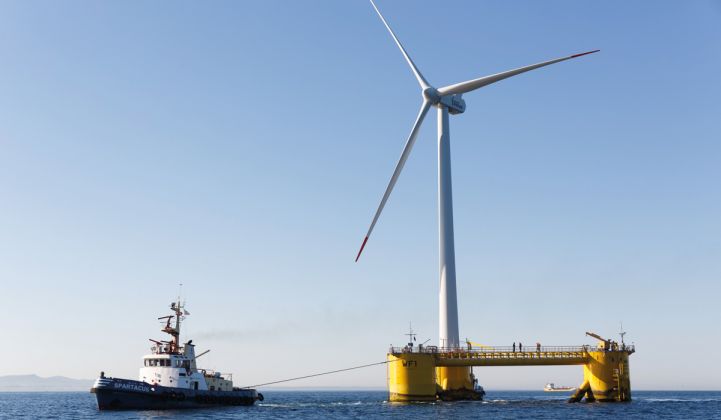The Norwegian government is set to unveil two sites for floating offshore wind plants later this year, a minister has confirmed.
Speaking at an industry event this month, Terje Søviknes, Norway’s minister of petroleum and energy, said the Norwegian Water Resources and Energy Directorate has already singled out four potential locations and is aiming to narrow down the selection this fall.
One or both sites might be connected to oil and gas platforms instead of exporting electricity to the grid, according to reports.
Although not stated specifically, it seems certain both sites will be developed by Equinor, the multinational energy company that changed its name from Statoil in March to reflect a switch in focus away from oil and gas and toward a wider energy portfolio approach.
Equinor already leads the nascent floating wind market. It is the only company to have developed a floating wind farm, the 30-megawatt Hywind Scotland project, which started exporting to the grid in October 2017 and is located 15 miles off the Aberdeenshire coast.
In June this year, Equinor and Hywind’s co-owner Masdar attached a land-based 1-megawatt/1-megawatt-hour lithium-ion battery system to the project, making it the first offshore wind farm to be equipped with energy storage.
Hywind uses a spar buoy floating foundation design adapted from the oil and gas industry. But Equinor faces growing competition from a host of floating wind turbine foundation technology developers with alternative designs.
In France, for example, the industrial giant Naval Energies, formerly called DCNS Energies, halted development of its OpenHydro tidal stream turbines to focus on floating offshore wind in July.
The company is touting a semi-submersible design that is slated for deployment at the 12-megawatt Maine Aqua Ventus pilot plant, being considered by the Maine Public Utilities Commission, and the 24-megawatt French Groix-Belle-Île project scheduled for 2020.
Another French floating foundation developer, Ideol, has a ring-shaped platform design that is being tested at the Ecole Centrale de Nantes’ offshore test site on France’s Atlantic coast. Other pilots are due to be launched in the French Mediterranean and off the coast of Japan.
Portugal, meanwhile, is planning to install three semi-submersible triangular floating platforms at a project called WindFloat Atlantic, which is due to come online next year.
Two of the platforms will be made by Portuguese firm ASM Industries and the third will come from Navantia-Windar, a Spanish joint venture.
Against this backdrop of heightened interest in floating offshore wind, Giles Dickson, CEO of the industry body WindEurope, called the Norwegian announcement “very good news.”
“It puts Norway, together with Scotland, France and Portugal, in a leading position to drive deployment of this key technology. Floating offshore wind is now well past research and development. It’s been shown to work and is ready for deployment at scale," said Dickson.
Europe could install 4 terawatts of floating offshore wind, he said, which is “significantly more” than the resource potential of the U.S. and Japan combined.
“Governments that are the first movers will benefit from continuous cost reductions and will accumulate the knowhow to export floating wind technology around the world,” Dickson said.
In Europe, he said, floating wind capacity commitments were expected to be put forward as part of the European Union 2030 National Energy Plans.
It appears Norway’s decision to move forward with test sites is driven more by this export potential than by a need to develop floating offshore wind for national electricity production.
The country is a net energy exporter, supplying around a quarter of the gas used across the European Union and having abundant hydro reserves. Globally, though, Equinor believes floating offshore wind could be big business.
It estimates around 13 gigawatts of floating capacity could be installed worldwide by 2030 and hopes to capture “a fair share” of the market, a Reuters report said in June.
Floating foundations are expected to be the technology of choice for several promising offshore wind markets where water depths exceed the 100- to 130-foot limit in which ground-mounted foundation designs are feasible.
Such markets include Japan, the Mediterranean countries and the West Coast of the U.S.




